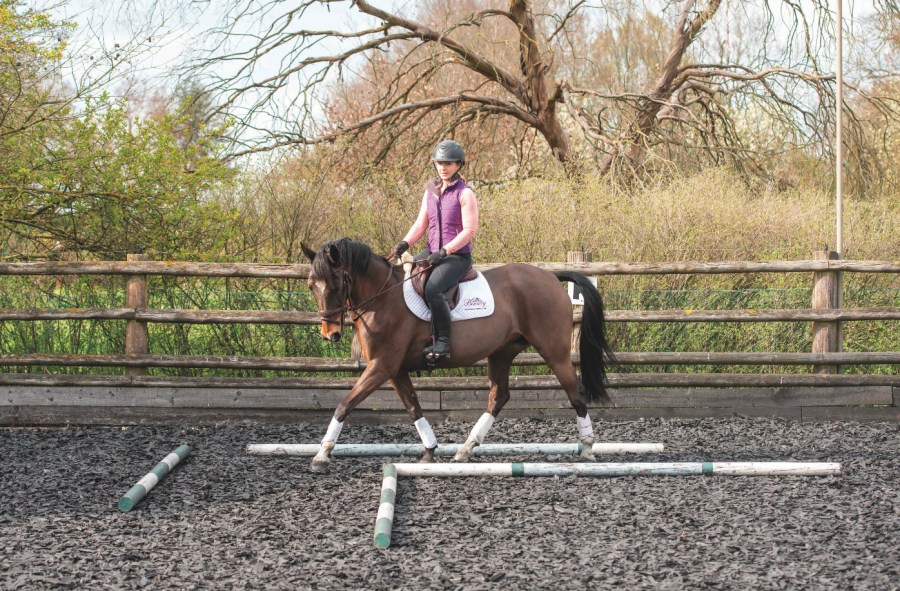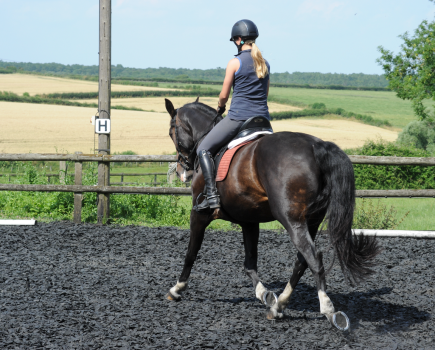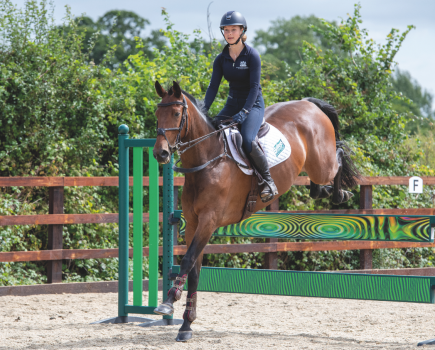Is your horse prone to falling on the forehand? International showjumper Matt Lanni four effective exercises to improve your horse’s balance and unleash his full potential.
Exercise 1: Lighten the load
If your horse has a naturally downhill way of going, the key thing to remember in the warm up is to allow him to go forwards and not worry too much if he’s slightly on the forehand.
“He must be going forwards,” explains Matt, “don’t take this away from him”.
How to ride it…
- Warm up on a loose rein, in walk and trot, encouraging your horse to stretch and allowing him forwards.
- Introduce lots of simple upward and downward transitions from walk to trot and trot to walk.
- If your horse falls on his forehand through the downwards transitions, remember to grow tall through your body as you ask for the change, and hug with your lower leg to encourage his back end to sit beneath him.
- Through every downwards transition, remember this key point: your horse must lift his poll, so the front of his face is at — and not inside — the vertical line.
- This will encourage him to become lighter in the shoulder.
- As a result, he’ll be able to come through from behind and sit on his haunches through the downwards transition.
Exercise 2: Circle with purpose
A simple exercise to help encourage your horse to lighten his forehand and develop a more balanced way of going is to place a single cone or pole at each end of your schooling area, so you can ride a 20m circle around them at A and C.
How to ride it…
- In trot, go large, and then ride a 20m circle around your pole or cone, at either A or C.
- As you circle, push your horse up and through with your inside leg into your outside rein. Think ‘up and active’.
- As you come off your circle, sit up and consciously lift your hands as you trot along the long side of the school.
- Repeat your 20m circle around the cone or pole at the opposite end of the school, again sitting up and thinking ‘lift’ with your hands as you leave the circle and hit the long side.
- Ride this exercise on both reins in trot, then try it in canter.
Exercise 3: Ride a 90° pivot turn
Also known as a turn on the haunches, this will really help to boost your horse’s suppleness and balance. And, as Matt explains, you can make this movement a lot easier to ride by setting up a simple right-angled tunnel of poles at opposite corners of your school or field.
How to ride it…
- Use four poles in each corner of your schooling area to create a tunnel in a right-angle shape (see main image, above).
- Ask for a 90° turn on the haunches, in walk, as you ride through your tunnel.
- As you ask for the turn, lead with your inside hand, while keeping your outside hand close to your horse’s neck.
- Your outside leg should stay near the girth as you ask your horse to walk his shoulders around his pivoting haunches.
- Once you’re confident in walk, try this exercise in trot, off both reins in both corners of the school; then progress to canter.
- Throughout this movement remember Matt’s mantra: your horse must lift his poll, so the front of his face is at — not inside — the vertical line.
Exercise 4: Keep your horse guessing
Many horses are smart enough to suss what’s being asked of them and start anticipating their next move. If this sounds familiar, you need to mix things up so that you stay in control, not your horse.
“Horses will often anticipate what you’re going to ask, so play around and keep them guessing,” says Matt.
It’s important that you are controlling where your horse goes, not him.
How to ride it…
- In trot, ride a 20m circle at A or C around a pole or cone (we’ve used a block).
- Straighten your horse up as you ride down the long side, then make a pivot turn onto the next short side.
- Repeat this exercise on both reins, mixing up when and where you ask for a circle/90° turn.
- As you circle, think ‘inside leg to outside rein’ and aim to have your horse forwards and round.
- As you hit the long side think ‘up and straight’, then think ‘up and on the haunches’ through your square turn.
- Throughout this exercise your horse must be going forwards, even if that movement is still a little downhill.
- With time you’ll encourage your horse to become lighter in his shoulder and carry more weight on his hind legs.









